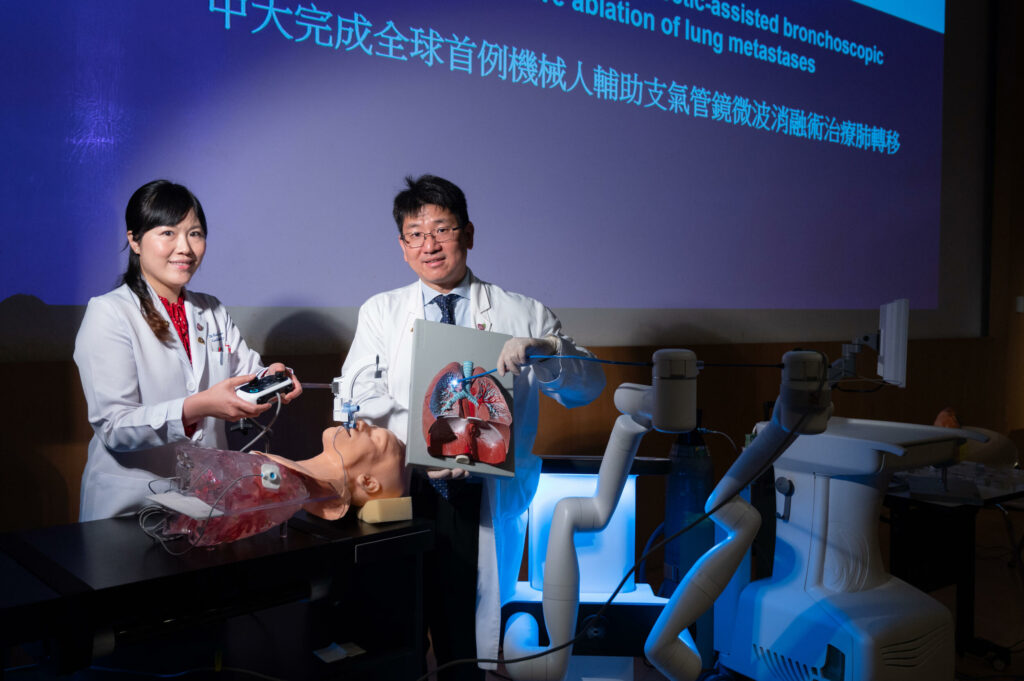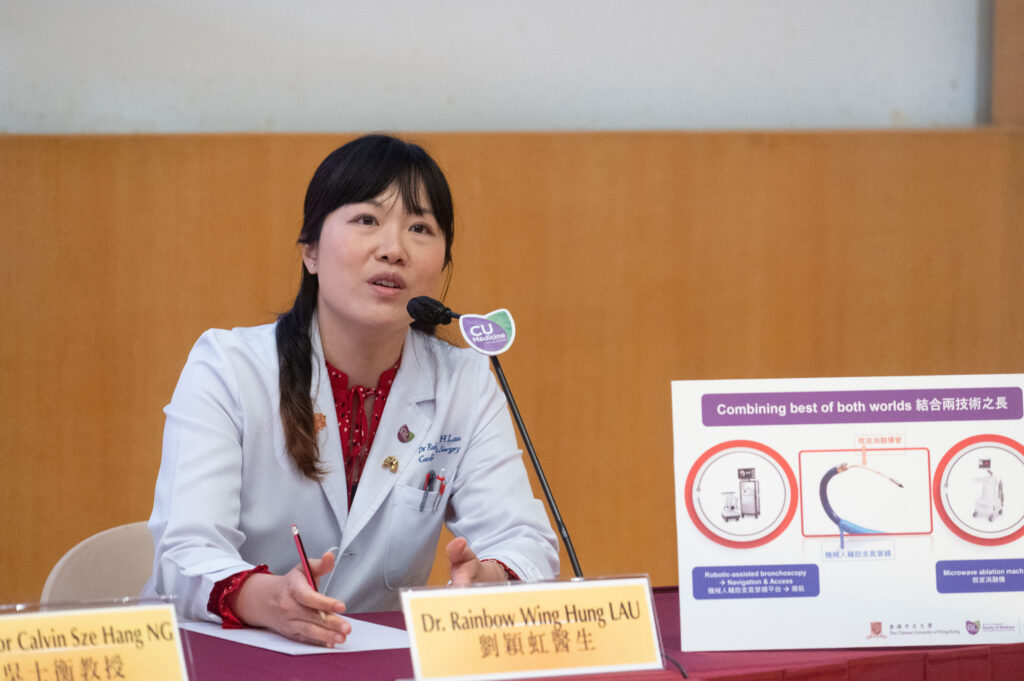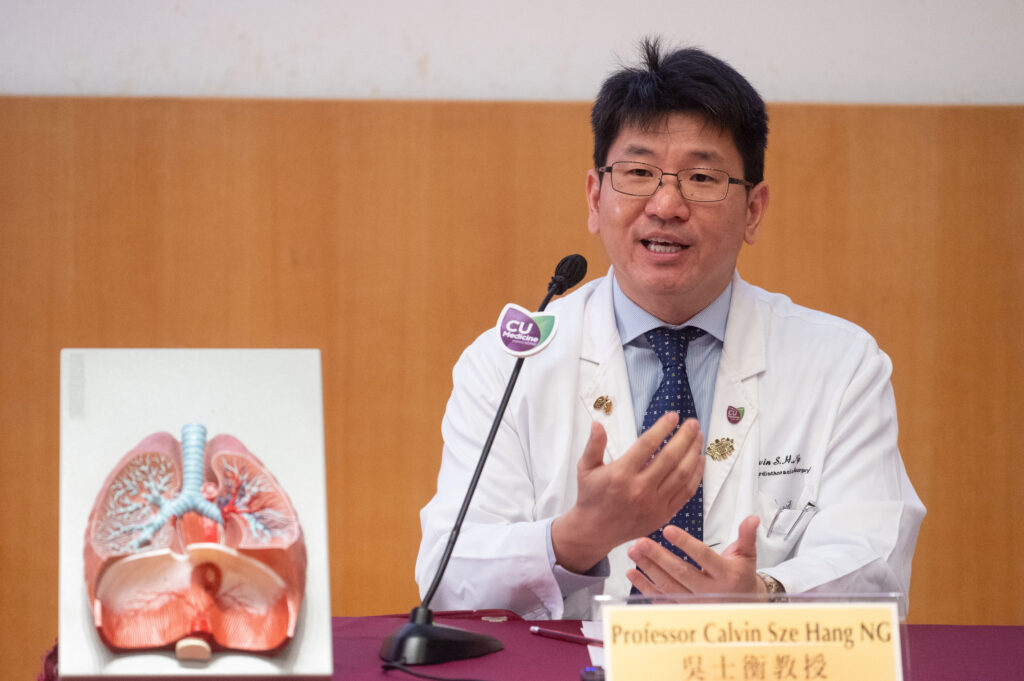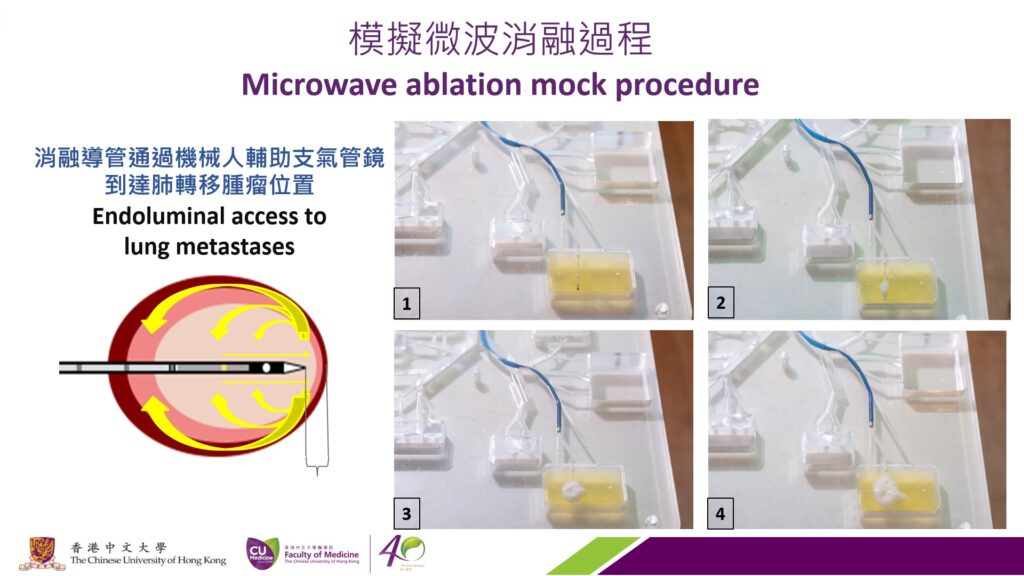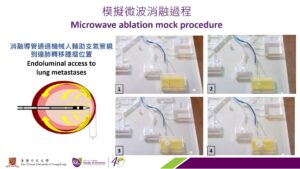CUHK
News Centre
CUHK performs world’s first robotic-assisted bronchoscopic microwave ablation of lung metastases
Malignant cancers from different organs often metastasise to the lung. Conventional surgical resection of lung metastases can be associated with significant surgical access trauma and undesirable removal of adjacent healthy lung tissue. The Chinese University of Hong Kong (CUHK)’s Faculty of Medicine (CU Medicine) performed the world’s first robotic-assisted bronchoscopic microwave ablation of lung metastases. Since October 2022, three patients with a total of six lung metastases have been successfully treated with ablation. This novel procedure allows physicians to accurately access peripheral areas of the lung and perform non-invasive lung sparing microwave ablation of lung metastases. It is now in clinical trial, with a target of enrolling up to 145 patients worldwide.
Robotic-assisted bronchoscopic microwave ablation of lung metastases can avoid surgical access trauma and protect lung function
Patients suffering from lung metastases have often had previous surgery or are undergoing chemotherapy for their advanced stage cancer. They may already be physically and psychologically weakened from the side effects of the different treatments they are receiving. Surgical resection is the main treatment modality for lung metastases; however, it is associated with access trauma and loss of healthy lung tissue.
Non-invasive transbronchial microwave ablation of lung metastases is a novel form of treatment that does not require surgical wounds and usually results in no pain or blood loss. Furthermore, the procedure is lung parenchymal sparing, as it does not involve removal of healthy lung tissue. A small catheter is passed down into the small airways to reach the lung metastases, and microwave energy is delivered to heat and destroy the cancer cells. To deliver the catheter precisely and perform ablation of peripheral lung metastases requires an advanced navigation bronchoscopy platform.
In recent years, CU Medicine has pioneered the use of bronchoscopy with navigational capabilities, which has enabled us to reach peripheral lung tumours for diagnostic and therapeutic purposes. The latest robotic-assisted bronchoscopy platform offers additional advantages over previous bronchoscopy systems by improving navigation accuracy to the lung lesions and subsequent procedural stability. Using robotic bronchoscopy for transbronchial microwave ablation of lung metastases is a novel treatment approach which can be a game-changer for those with advanced stage metastatic cancer of the lung.
Dr Rainbow Lau Wing-hung, Clinical Assistant Professor (honorary) from the Division of Cardiothoracic Surgery, Department of Surgery at CU Medicine, explained, “Bronchoscopy is a form of endoscopic procedure, usually performed by doctors specialising in lung disorders. The novel robotic-assisted bronchoscopy uses real-time optical imaging and electromagnetic positioning to enable the operator to navigate the complex human airways. The procedure is performed using a remote console that is linked with the robotic arms and bronchoscope to accurately drive the device to the desired location within the lung. The advanced robotic mechanism within the bronchoscope also maintains stability while the microwave ablation catheter is deployed, improving the accuracy and efficiency of the ablation procedure.”
CU Medicine is a pioneer in thoracic surgical treatments in the Asia-Pacific region
The thoracic surgical team at CU Medicine has been pioneering advanced minimally invasive techniques using the latest technologies, including single port video-assisted thoracoscopic surgery for major lung resection, image-guided surgery and navigation bronchoscopy in the Hybrid Operating Room. The latest robotic-assisted bronchoscopic microwave ablation of lung metastases is another breakthrough from the pioneering team.
Professor Calvin Ng Sze-hang, Professor from the Division of Cardiothoracic Surgery, Department of Surgery at CU Medicine, remarked, “We are very excited to have performed the world’s first robotic-assisted bronchoscopy microwave ablation of lung metastases. By combining the benefits of precise airway navigation with robotic bronchoscopy and our world-leading experience in transbronchial microwave ablation of lung tumours, we can now give our patients with lung metastases an additional treatment option which is non-invasive.
“Often, advanced cancer patients have multiple lung metastases distributed throughout both lungs. Under these circumstances, treatment by conventional surgical resection involves bilateral surgical incisions and removal of multiple wedges of lung tissue that can significantly affect the patient’s lung function, and may even lead to delay in administration of chemotherapy as the patient recovers from surgery. Our novel approach using robotic bronchoscopic microwave ablation allows multiple bilateral lung metastases to be treated without incisions or lung resection, meaning almost no impact on patient’s lung function or quality of life.”
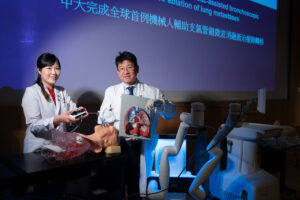
CU Medicine has become the world’s first institution to perform robotic-assisted bronchoscopic microwave ablation of lung metastases.
(From left) Clinical Assistant Professor (honorary) Dr Rainbow Lau Wing-hung and Professor Calvin Ng Sze-hang from the Division of Cardiothoracic Surgery, Department of Surgery at CU Medicine.

Dr Lau says the advanced robotic mechanism within the bronchoscope maintains stability while the microwave ablation catheter is deployed, improving the accuracy and efficiency of the ablation procedure.


